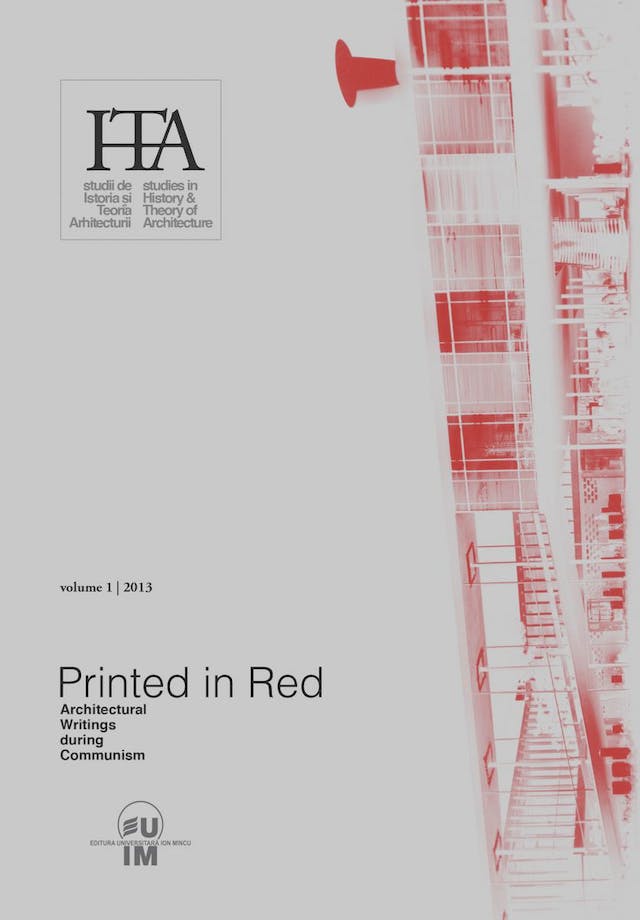Star-topped Spires and Cardboard HeroesSoviet Socialist Realism in Arhitectura R.P.R.
Star-topped Spires and Cardboard Heroes
Soviet Socialist Realism in Arhitectura R.P.R.
by
Ioana C. Popovici
Keywords
Socialist Realism
Romanian architecture
Soviet architecture
Arhitectura R.P.R.
architecture theory
architecture practice
This article examines the portrayal of Soviet Socialist Realism in Arhitectura R.P.R., and its effects on the development of Socialist Realist architecture in Romania. During the first three years of post-war publication, the numerous articles on the subject featured in Arhitectura amounted to a theoretical guide to the method of Socialist Realism (illustrated with recurring Soviet architecture models), meant to facilitate translation into local architectural language. But this call for the creative discursive exchanges needed to attune Socialist Realist principles and local cultural context elicited less critical engagement than expected, as suggested by the period’s theoretical works and architectural production. The portrayal of Socialist Realism in Arhitectura contributed to this outcome.
In theory, Socialist Realism remained entrenched in ideology and political jargon, operating with terms relevant in a Russian cultural context (radiance, clarity, optimism), perpetuated in Romanian interpretations of key theoretical texts as conceptual abstractions with little formal implication. Practice, however, was ruled by economic and technical constraints, and hinged on deference to the Soviet architecture canon, despite Arhitectura’s promotion of Socialist Realism as method calling for conceptual and formal flexibility. This contrast (and distance) between theoretical permissiveness and the rigid framework of practice further destabilized the discourse of Socialist Realism in Romania.
Romanian Socialist architecture was one of modest construction volume, inconsistent quality and bipolar expression (mass vs. unique programs) - a quick response to external demand, rather than an adaptation sprung from critical engagement with the actual method. A contributing factor was the miscommunication of Socialist Realism’s potential for architectural versatility, as demonstrated in Catherine Cooke’s study “Beauty as a Route to ‘the Radiant Future’: Responses of Soviet Architecture”. Arhitectura’s promotional campaign reveals a partial, theoretically cryptic and culturally un-filtered transmission of the original message, highlighting the distance between the method’s pre-war conceptual flexibility and the limited scope of its local application during Stalinism. Architecture theory was under-represented, steeped in political jargon, and overshadowed by concrete examples from Soviet practice. The predominant perspective was Romanian, but one lacking enough information to unearth the conceptual core behind the jargon, and attempt a translation of the spatial implications carried by concepts which were self-explanatory in a Soviet cultural context. Crucial ideas like flexibility in manipulating space, contextuality, distinctiveness, appealing to the collective imaginary through creative use of local spatial precedent, became secondary to the accurate transmission of propagandistic messages, which focused the argument on formal representation.
Socialist Realism was a total vision of irradiating power and order at an urban level. In architecture, the initial method also carried a realistic, humanistic dimension – in the sense of an appropriateness and adaptability of scale and image to place, program, user, and an honest expression derived from addressing complex functions in a clear, classical language. Through the dynamic, uplifting movement of representative building silhouettes, and polychrome exterior decoration (halfway between idealized depiction of life under socialism and the vivacity of popular art), the built environment was also liable to positively influence the psychology of inhabitants. Ideally, Socialist Realism was to be culturally tailored to each new environment – and this was the profile emerging from the pages of Arhitectura. In Eastern Europe, however, it was introduced not only at a time when, in the USSR, the discourse had entered an authoritative stage (architectural language played decoration to ideology), but also as an instrument of sovietization, used against local spatial traditions.
In Arhitectura, this confusing contradiction came across quite strongly: a utopian vision of unprecedented scale, whose Muscovite iconography substituted itself to the permissive theory frustratingly alluded to, but inaccessible for a critical adaptation to the Romanian context. The use of ‘national forms’ reclaimed from progressive traditional architecture was inadequate compensation. Symbolically nullified by excessive, decorative use, they did little for the cultural contextuality of Socialist architecture. Until 1952, Romania’s wide-scale heavy industrialization and modern infrastructure development barred Socialist Realism from architectural exclusivity. Ill-suited to the technical requirements of industrial, transport or health architecture, it gravitated towards grand-scale, representative urban programs and mass housing. This helped maintain a duality of architectural discourses, transferring the modernist aesthetic across the Stalinist period.
The space of creative maneuverability afforded architects in the original method – and promised to Romanian architects in Arhitectura - was lost in (mis)translation, precluding within-the-rules architectural experiment and critical discussion – limited though they may have been due to political intervention in architecture practice during the delicate stage of socialist regime consolidation. Socialist Realism as promoted in Arhitectura had two destabilizing traits, affecting the emergence of a Romanian Socialist architecture: a grandiose vision of fast-paced, total transformation of the built environment (practically unfeasible at the time, and perceived by the professional milieu as a distant utopia), and a mandatory deference to a Soviet architecture model (built on Russian cultural and architectural precedent), which worked against a possible local adaptation of the method.
Chicago citation style
DOI:
10.54508/sITA.1.07
